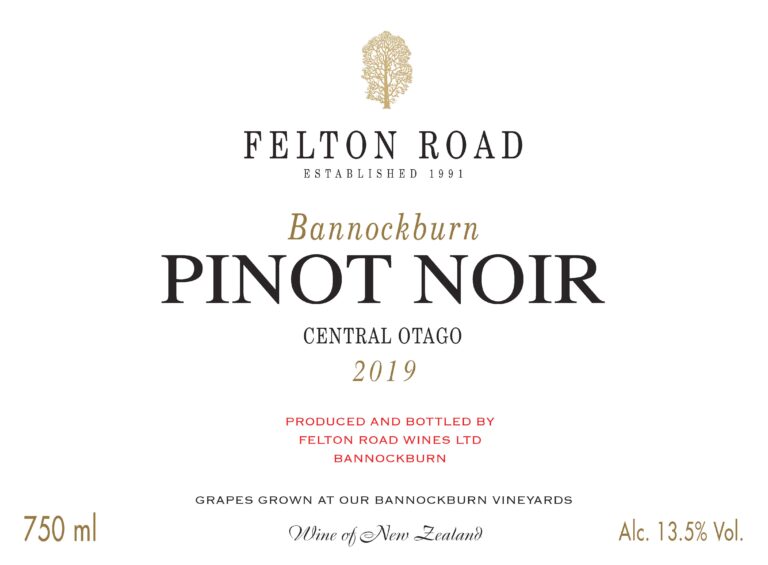2019 Vintage
Scroll down for more vintages
-

2023 Vintage (4)
-

2022 Vintage (13)
-

2021 Vintage (13)
-

2020 Vintage (11)
-

2019 Vintage (11)
-

2018 Vintage (11)
-

2017 Vintage (11)
-

2016 Vintage (12)
-

2015 Vintage (11)
-

2014 Vintage (10)
-

2013 Vintage (11)
-

2012 Vintage (10)
-

2011 Vintage (12)
-

2010 Vintage (10)
-

2009 Vintage (11)
-

2008 Vintage (11)
-

2007 Vintage (10)
-

2006 Vintage (11)
-

2005 Vintage (7)
-

2004 Vintage (9)
-

2003 Vintage (10)
-

2002 Vintage (8)
-

2001 Vintage (9)
-

2000 Vintage (7)
-

1999 Vintage (8)
-

1998 Vintage (6)
-

1997 Vintage (6)

2019 Pinot Noir Bannockburn
Dark raspberry, hints of the leaves as well, with a touch of old cedar wood panelling. The palate is viscous and concentrated, displaying cane fruits that deftly integrate with an alluring savouriness. Fine, long tannins with no shortage of chew, but no harshness. This is at a level way above its Bannockburn “village” designation, being a blend of our four primely situated vineyards. A serious wine with considerable definition and poise.
Vintage Summary 2019
Growing Season & Vintage Conditions
WINTER: Following a dry winter, above average rainfall and frost events in September revealed a pattern that was to shape the season.
OCTOBER: A major frost event on October 13 was the most severe since 2003. Shoots were in their infancy and protective frost fighting activities were required through the night. Fortunately, this event occurred early enough in our growing cycle that damage was limited to just a few specific areas and affected vines were largely able to recover, aided by plentiful soil moisture.
NOVEMBER: Although air temperatures varied little from average, the cool, calming effect of early soil moisture could be seen in the vineyards. Notably verdant inter-rows separated vines where potential vigour was balanced by the stultifying effects of cooler soil temperatures.
DECEMBER: As is typical, we began to see first evidence of flowering at the start of December, a process protracted by occasional cooling rain events, reaching completion mid-month. Just like the weather, fruit set was varied with small, shattered bunches most evident in the free-draining soils at Cornish Point and the lower slopes of Elms vineyard.
JANUARY: In what was to be the wettest season in recent memory, the longest period without rainfall occurred at the end of December until January 6. However, this dry spell was bookended by significant rain events of over 20mm. Soils remained moist and irrigation taps remained firmly closed.
FEBRUARY: When the first signs of veraison became apparent (mid-month), the variation in bunch and berry development was further highlighted. Above average rainfall persisted accompanied by moderate temperatures. Compared with the rapid advance of the previous vintage, 2019’s development was gently (and pleasingly) measured.
MARCH: Following above average temperatures for the month, harvest began at Cornish Point on March 29. After a season of patient development, the window for picking would prove to be tight. With the exception of Block 1 Riesling, all the fruit was picked in an 12 day window. The entirety of our Chardonnay was picked over 5 consecutive days from March 30 to April 4.
Select a variety from the page tabs at the top or choose another vintage from the dropdown

2019 Pinot Noir Bannockburn
Dark raspberry, hints of the leaves as well, with a touch of old cedar wood panelling. The palate is viscous and concentrated, displaying cane fruits that deftly integrate with an alluring savouriness. Fine, long tannins with no shortage of chew, but no harshness. This is at a level way above its Bannockburn “village” designation, being a blend of our four primely situated vineyards. A serious wine with considerable definition and poise.
Vintage Summary 2019
Growing Season & Vintage Conditions
WINTER: Following a dry winter, above average rainfall and frost events in September revealed a pattern that was to shape the season.
OCTOBER: A major frost event on October 13 was the most severe since 2003. Shoots were in their infancy and protective frost fighting activities were required through the night. Fortunately, this event occurred early enough in our growing cycle that damage was limited to just a few specific areas and affected vines were largely able to recover, aided by plentiful soil moisture.
NOVEMBER: Although air temperatures varied little from average, the cool, calming effect of early soil moisture could be seen in the vineyards. Notably verdant inter-rows separated vines where potential vigour was balanced by the stultifying effects of cooler soil temperatures.
DECEMBER: As is typical, we began to see first evidence of flowering at the start of December, a process protracted by occasional cooling rain events, reaching completion mid-month. Just like the weather, fruit set was varied with small, shattered bunches most evident in the free-draining soils at Cornish Point and the lower slopes of Elms vineyard.
JANUARY: In what was to be the wettest season in recent memory, the longest period without rainfall occurred at the end of December until January 6. However, this dry spell was bookended by significant rain events of over 20mm. Soils remained moist and irrigation taps remained firmly closed.
FEBRUARY: When the first signs of veraison became apparent (mid-month), the variation in bunch and berry development was further highlighted. Above average rainfall persisted accompanied by moderate temperatures. Compared with the rapid advance of the previous vintage, 2019’s development was gently (and pleasingly) measured.
MARCH: Following above average temperatures for the month, harvest began at Cornish Point on March 29. After a season of patient development, the window for picking would prove to be tight. With the exception of Block 1 Riesling, all the fruit was picked in an 12 day window. The entirety of our Chardonnay was picked over 5 consecutive days from March 30 to April 4.





